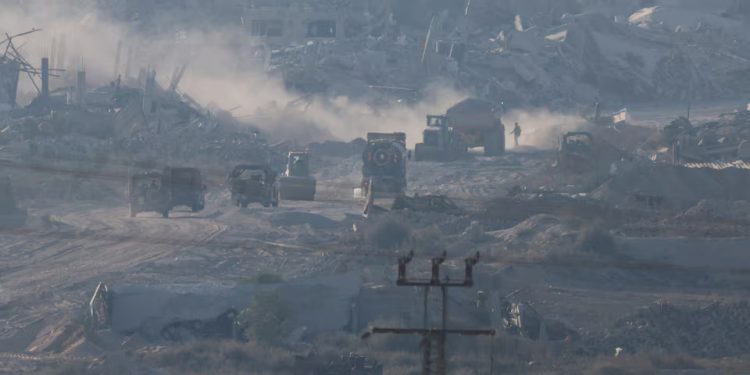Shells rained down on the neighbourhoods of Tal Al-Hawa, Sheikh Ajlin and Al-Sabra in Gaza City, AFP correspondents reported, while eyewitnesses said the Israeli army had shelled the Al-Mughraqa area and the northern outskirts of the Nuseirat refugee camp in central Gaza.
Paramedics from the Palestinian Red Crescent said they had retrieved the bodies of five people, including three children, after Israeli air strikes in the Al-Maghazi camp, also in the central Gaza Strip.
Meanwhile, eyewitnesses reported Israeli gunship fire east of Khan Yunis, in southern Gaza, and shelling and Apache helicopter attacks in western areas of the southernmost city of Rafah.
The Israeli military said in a statement that it was continuing its activity throughout the coastal territory, and said it had conducted raids in Rafah and central Gaza that killed “a number of” militants, as well as air strikes throughout the strip over the past day.
It also said its naval forces had been firing at targets in Gaza.
– Talks on hold –
The relentless bombardments came as prospects dwindled for a truce and hostage release deal being secured any time soon.
Hamas, the Iran-backed Islamist group that Israel has been fighting in Gaza for over nine months, said on Sunday it was withdrawing from ceasefire talks.
The decision followed an Israeli strike targeting the head of Hamas’s military wing, Mohammed Deif, which the health ministry in Hamas-run Gaza said killed 92 people.
Deif’s fate remains unknown, with Israeli Prime Minister Benjamin Netanyahu saying there was “no certainty” he was dead while a senior Hamas official told AFP that Deif was “well and directly overseeing” operations.
Speaking after the strike on Al-Mawasi, a second senior official from the militant group cited Israeli “massacres” and its attitude to negotiations as a reason for suspending negotiations.
But according to the official, Haniyeh told international mediators Hamas was “ready to resume negotiations” when Israel’s government “demonstrates seriousness in reaching a ceasefire agreement and a prisoner exchange deal”.
Last week, US President Joe Biden had suggested a deal might be close, saying at a NATO summit that both sides had agreed to a framework he had set out in late May.
Hamas on Monday lashed out at the US, accusing it of supporting “genocide” by supplying Israel with “internationally banned” weapons.
“We condemn in the strongest terms the… American disdain for the blood of the children and women of our Palestinian people… by providing all types of prohibited weapons to the ‘Israeli’ occupation,” a statement from the Hamas government media office said.
Talks between the warring parties have been mediated by Qatar and Egypt, with US support, but months of negotiations have failed to bring a breakthrough.
– School hit –
The war was sparked by Hamas’s surprise October 7 attack on southern Israel, which resulted in the deaths of 1,195 people, mostly civilians, according to an AFP tally based on Israeli figures.
The militants also seized 251 hostages, 116 of whom are still in Gaza including 42 the Israeli military says are dead.
Israel responded with a military offensive that has killed at least 38,584 people in Gaza, also mostly civilians, according to data provided by the Gaza health ministry.
The war and accompanying siege have devastated the Palestinian territory, destroying much of its infrastructure, leaving the majority of its 2.4 million residents displaced and causing a dire shortage of food, medicines and other basic goods.
Among the devastated facilities have been multiple schools. On Sunday, Israeli forces struck a UN-run school in Nuseirat camp that was being used as a shelter for displaced people but which the military said “served as a hideout” for militants.
The civil defence agency in Gaza said 15 people were killed in the strike, the fifth attack in just over a week to hit a school used as shelter by displaced Palestinians.
AFP




















